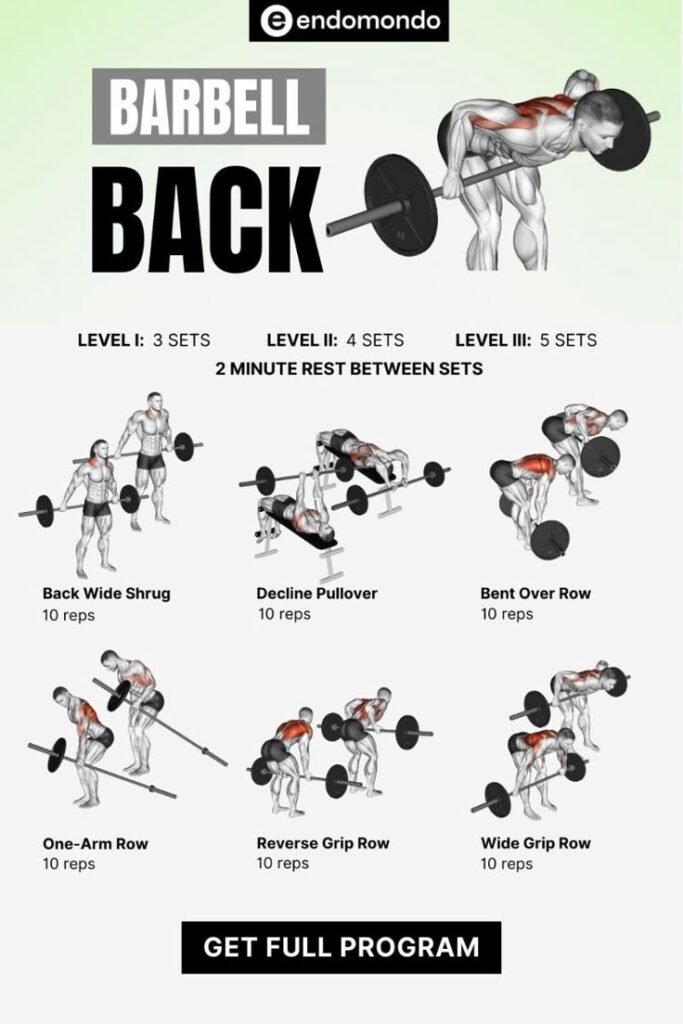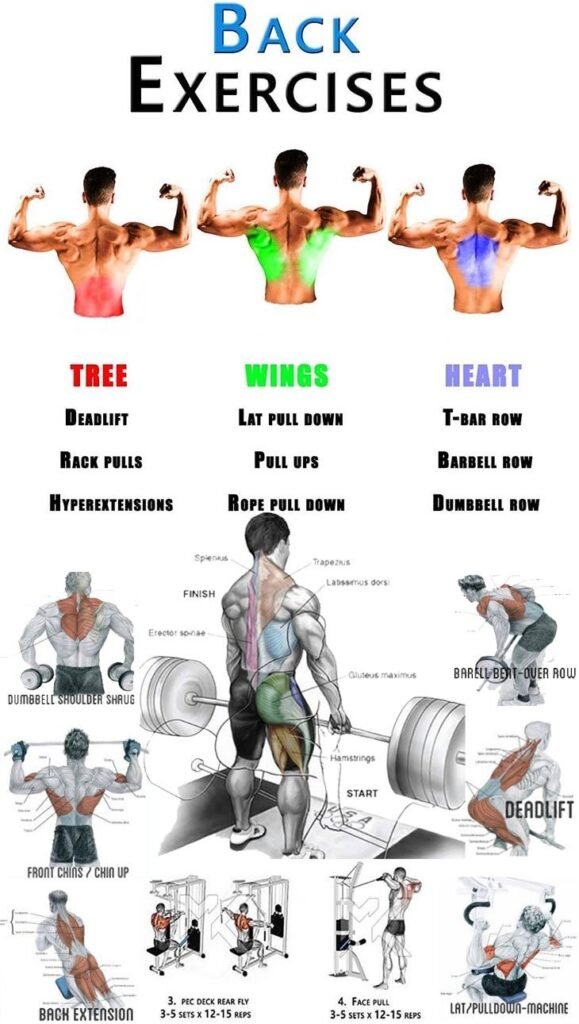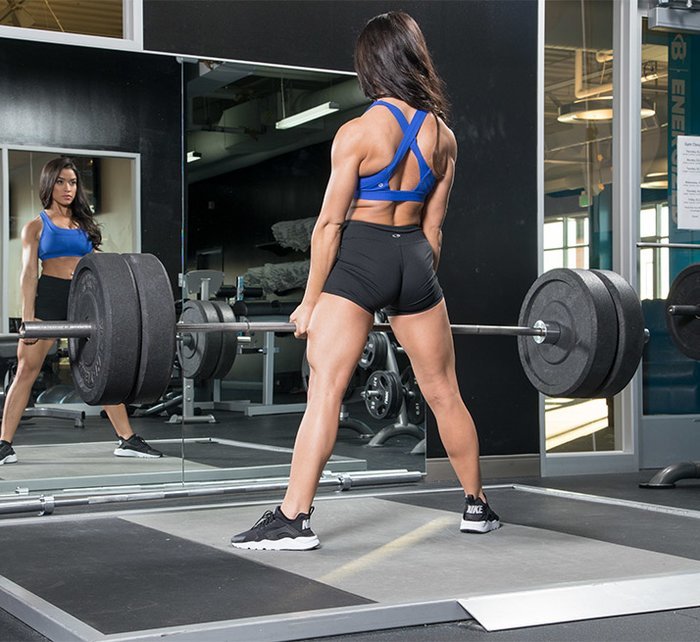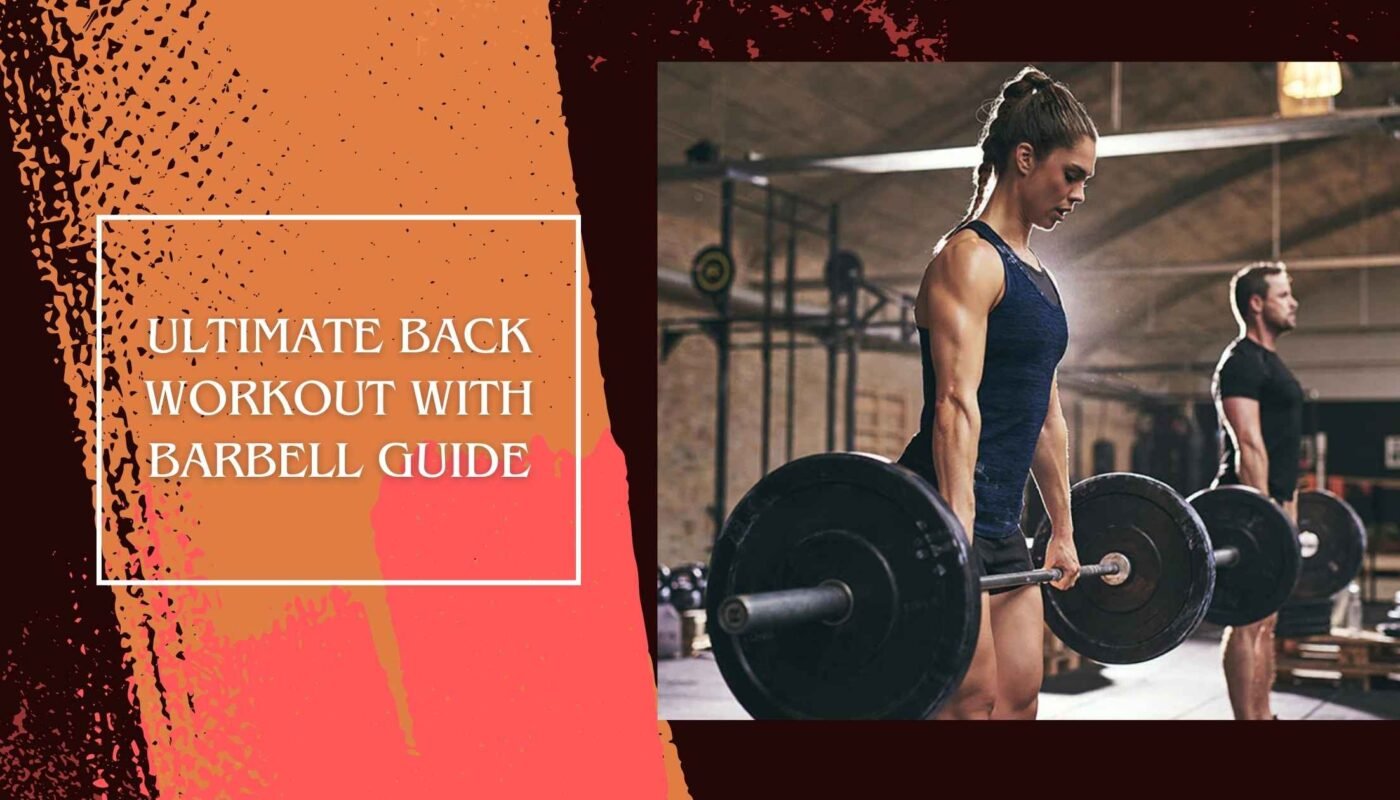Imagine stepping into the gym, feeling energized, but unsure where to channel that energy. You notice many gym-goers focus on their backs. A strong back improves posture and is key for a powerful physique.
You start exploring back workouts with barbells. You learn these exercises can shape your muscles and boost your athletic performance.

Barbell exercises for back strength include the deadlift and the barbell row. These exercises work on the latissimus dorsi, rhomboids, and trapezius. They help prevent injuries and improve symmetry, just like Arnold Schwarzenegger and Phil Heath recommend.
These workouts let you lift heavier weights, which is great for muscle engagement and strength. You’re drawn to techniques like the Pendlay row and Romanian deadlifts. You’re excited to try these and improve your training.
Curious about the best barbell back exercises, you’re ready to start your journey to a strong, defined back.
For more on essential back exercises, check out this resource on back exercises for superior strength and.
Table of Contents
Understanding Back Muscle Anatomy
Learning about back muscle anatomy is key to good training. The back has many key muscle groups that help with movement and stability. Working on these muscles boosts performance and lowers injury risk.
Key Muscle Groups in the Back
The back includes these main muscle groups:
- Latissimus Dorsi: These muscles run from the lower back to the shoulder and are the biggest. They help with width and strength.
- Trapezius: This muscle goes from the neck to the mid-back. It has upper, middle, and lower parts that help with posture.
- Rhomboids: The rhomboid major and minor help pull the scapula back and keep the shoulder stable.
- Erector Spinae: These muscles keep the spine stable and work with the glutes for posture.
Importance of Targeting Multiple Muscles
Using back exercises with barbell helps engage more muscles and promotes balanced growth. Deadlifts and bent-over barbell rows work on lats, traps, delts, and rhomboids. This method is key for strength and better function.
Knowing about key muscle groups and their roles guides your training. For more on back muscle anatomy, check out this resource.
Benefits of Barbell Training for the Back
Barbell training brings many benefits to a back workout. It lets you lift heavier weights, which is key for deep muscle growth. This makes back workouts more effective.
Increased Load Capacity
Lifting heavier weights is a big plus of barbell training. It’s crucial for muscle growth and strength. By lifting more, you work more muscle fibers.
Doing exercises like deadlifts and rows helps improve your limits. It also makes your form and technique better. This helps you reach your fitness goals and break through plateaus.
Compound Movements for Overall Strength
Barbell training uses compound exercises that work many muscles at once. This builds muscle and boosts overall strength. Exercises like deadlifts and bent-over rows work key back muscles.
These exercises help improve athletic performance. They are key to a good back workout plan.
What Makes a Great Back Workout
A great back workout needs careful planning and focus. It’s important to use grip variations to improve your routine. These variations help target different muscle fibers in the back for better results.
Incorporating Different Grip Variations
Using different grips is key to working out the upper back and lats well. Here are some grip styles to try with your barbell back exercises:
- Overhand grip: Works on the upper traps and lats.
- Underhand grip: Focuses on the lower traps and rhomboids.
- Neutral grip: Keeps your shoulders comfortable and works multiple muscles.
These grip styles help engage more muscles and improve strength.
Importance of Progressive Overload
Progressive overload is crucial for strength training. It means slowly adding more weight or resistance to challenge your muscles. To get the most out of your back exercises, keep checking your progress and adjust as needed.
Here are tips for progressive overload:
- Slowly increase weights while keeping proper form.
- Change the number of reps to keep muscle growth going.
- Add new exercises to keep your muscles guessing.

Essential Barbell Back Exercises
Doing essential barbell back exercises is key for a strong back. Each exercise targets different muscles, making workouts well-rounded. A good barbell back workout includes various movements. This helps improve strength and muscle size.
Overview of Key Exercises
Deadlifts are a top exercise for the back, focusing on the legs and back. Pendlay rows help increase strength with explosive reps. T-bar rows focus on strength and muscle growth. Meadows rows work the core and improve grip strength.
Other important exercises include:
- Chest supported barbell rows isolate upper back muscles and ease lower back pressure.
- Close-grip rows work the lats and rhomboids effectively.
- Standard bent-over rows target mid- and upper-back muscles, improving scapular movement.
- Wide-grip rows focus on rhomboids, traps, and posterior deltoids.
- Barbell pullovers boost lat strength and muscle growth.
Importance of Exercise Variety
Using different exercises prevents plateaus and engages various muscle fibers. A mix of exercises boosts strength and muscle growth. This variety keeps workouts interesting and helps with fitness progress.
Combining exercises like deadlifts with unilateral movements improves daily strength.
Barbell Back Workout: Best Practices
When you do a barbell back workout, knowing key practices can make it better. It’s important to focus on form and technique to avoid injuries and work effectively. Also, picking the right weight is key to moving forward safely and well.
Form and Technique Tips
Good barbell back workouts rely on the right form and technique. Here are some important tips:
- Keep your spine neutral during all exercises.
- Use your core to keep your posture stable.
- Control your movements to prevent sudden jerks.
- Make sure your grip is correct for the best muscle activation.
These tips improve your performance and help prevent injuries in exercises like the Barbell Deadlift, Bent-Over Barbell Row, and Good Mornings.
Choosing the Right Weight
Choosing the right weight is also crucial for a good barbell back workout. Beginners should start with weights they can handle to get their technique right. Here are some tips to think about:
- Start with lighter weights to feel confident in your form.
- Gradually increase the weight as you get better at the exercises.
- If you feel pain, lower the weight or check how you’re doing it.
Using these barbell back workout tips can greatly improve your performance and make your workouts safer and more fun.
Back Workout with Barbell Routine for Beginners
For beginners, a key focus is on basic movements for strength and endurance. A structured routine helps build foundational skills and ensures safety. Essential exercises include barbell deadlifts, bent-over rows, and barbell shrugs. These exercises work different back muscles for balanced development.
Starting with Basic Movements
Adding basic movements to your routine boosts back strength and function. For beginners, consider these exercises:
- Barbell Deadlift: Targets the erector spinae and engages multiple muscle groups.
- Bent-Over Barbell Row: Focuses on the latissimus dorsi and rhomboids.
- Barbell Shrug: Isolates and strengthens the trapezius muscles.
Recommended Sets and Reps
Choosing the right sets and reps is key for progress. Here are some recommendations for each exercise in your routine:
| Exercise | Recommended Sets | Recommended Reps |
|---|---|---|
| Barbell Deadlift | 3 | 8-10 |
| Bent-Over Barbell Row | 3 | 8-12 |
| Barbell Shrug | 3 | 10-12 |
Make sure to rest well between sets for recovery. Starting with these sets and reps prepares you for more complex exercises. Focus on proper form and technique to build a strong back workout foundation.

Upper Back Workouts with Barbell
Working on your upper back is key for strength and good posture. Using a barbell in your workouts helps engage more muscles and prevents mistakes. These mistakes can hurt your results or cause injuries. Here are some top exercises for building a strong upper back and tips for your workouts.
Best Exercises for Upper Back Development
For the best upper back workouts, add these exercises to your routine:
- Barbell Rows: This exercise works many muscles, like the trapezius and rhomboids, to improve strength and size.
- Reverse-Grip Bent-Over Rows: This version targets the upper back muscles from a different angle.
- Rear Delt Rows: This targets the rear deltoids, helping to balance your upper body strength.
- Landmine Rows: These are versatile and easier on the lower back, offering muscle activation similar to regular rows.
Common Mistakes to Avoid
When doing these exercises, avoid mistakes to keep your form right and get the most out of them:
- Using too much momentum can make your movements inefficient and increase injury risk.
- Hunching over too much reduces muscle activation and strains the back.
- Ignoring control during reps lessens the exercise’s benefits.
Focus on proper form and engaging the right muscles for effective upper back workouts. This approach improves posture and builds upper body strength.
| Exercise | Muscles Targeted | Key Points |
|---|---|---|
| Barbell Rows | Trapezius, Rhomboids, Lats | Focus on a controlled movement to avoid swinging. |
| Reverse-Grip Bent-Over Rows | Upper Back, Biceps | Maintain a neutral spine throughout. |
| Rear Delt Rows | Rear Deltoids, Upper Trapezius | Keep elbows above the back for better engagement. |
| Landmine Rows | Middle Trapezius, Rhomboids | Utilize the barbell’s angle for a less strenuous position. |
Lower Back Barbell Exercises
Strengthening the lower back is key for good health. Over 577 million people worldwide suffer from lower back pain. Doing exercises for the lower back helps ease pain, boosts core strength, and improves daily activities. It’s important to focus on safety and effective workouts to keep up with your fitness goals.
Focus on Safety and Technique
When doing lower back exercises, safety first is a must. Proper lifting is vital to avoid injuries. Always warm up before starting intense workouts. Here are some important safety tips:
- Maintain a neutral spine while executing lifts.
- Use controlled movements to prevent jerking motions.
- Engage your core muscles throughout the exercise.
- Gradually progress weight to avoid strains.
- 【4 in 1 Multifunctional Dumbbell Set】With it, you can get a pair of dumbbells also barbells, kettlebells, and push-up st…
- 【More Weight Options】The dumbbell pieces feature a detachable design, and the adjustable weight range for the single dum…
- 【Durable & Odorless】Environmentally dumbbell pieces’ exterior is made of high-quality PE materials, and the inside is mi…

- 54 lb Barbell Weight Set includes: – 3 piece bar, Two (2) spring collars, Two (2) 11lb Weights, Four (4) 5.5lb Weights a…
- Cushioned bar allows for comfort and versatility while lifting and squatting. The most comfortable bar you will find for…
- The handled weight design allows for nearly unlimited exercise uses. Weights can now be used on or off the bar. Simply g…

- SET INCLUDES – A pair of 5-pound, 10-pound, 15-pound, 20-pound, and 25-pound coated hex dumbbells and a blue A-frame dum…
- SPACE-SAVING DESIGN – The A-frame design of this rack maximizes floor space by storing dumbbells in an A shape, or verti…
- DURABLE AND RELIABLE – A-frame rack made with steel and finished with durable powder coat. Heads are made from ASTM A48 …

Building Strength in the Erector Spinae
Working on the erector spinae is key for a strong lower back. Deadlifts and good mornings are great exercises for this. They help with stability and strength. Regular training can reduce pain and improve how well you function. Here are some exercises you should try:
| Exercise | Description | Benefits |
|---|---|---|
| Deadlifts | Lift a barbell from the ground to hip level, focusing on form. | Builds overall strength, targeting the erector spinae significantly. |
| Good Mornings | With a barbell on your back, hinge forward at the hips. | Strengthens the spinal erectors while challenging stability. |
| Bent-Over Rows | Pull a barbell towards your hip while bent at the waist. | Targets upper and lower back muscles, enhancing overall strength. |
| Rack Pulls | Perform a deadlift with the barbell elevated to reduce leg drive. | Emphasizes back muscles, particularly beneficial for those with a squat to deadlift imbalance. |
Adding these exercises to your routine can make your erector spinae stronger and reduce lower back pain risks. Spending time on strengthening this area can lead to better athletic performance, a better quality of life, and less pain.
Integrating Barbell Rows in Your Workout
Barbell rows are key for boosting back strength. They come in many styles, each with its own benefits. Knowing the different types helps you plan your workouts better.
Types of Barbell Rows Explained
There are several types of barbell rows, including:
- Bent-Over Barbell Rows: Works multiple back muscles like the latissimus dorsi, rhomboids, and traps.
- Pendlay Rows: Focuses on explosive power and proper form, needing complete resets between reps.
- T-Bar Rows: Targets the upper back with a unique angle for effective muscle activation.
- Meadows Row: Also known as the “kroc row,” is great for building a strong and defined back.
- Good Mornings: Primarily targets the lower back but also works the glutes and hamstrings.
Changing hand positions in these rows changes which muscles work, making each row more effective.
Benefits of Different Row Variations
Using various barbell rows brings many benefits. Each type works different muscles and boosts pulling power:
- Bent-over rows mainly work the mid-lower traps and rhomboids.
- Pendlay rows add explosiveness and focus on upper traps.
- T-Bar rows improve overall upper body pulling strength.
Adding these barbell rows to your routine refreshes strength training. It also works different muscle fibers, leading to better muscle growth and development.

Creating a Balanced Back Workout Plan
To get a well-shaped back, mix compound and isolation movements in your workout plan. This approach makes sure all back muscles get worked out. It boosts strength and improves how well you move.
Combining Compound and Isolation Movements
Use compound moves like the Barbell Deadlift and Bent Over Barbell Rows. Add in isolation exercises like Single-Arm Dumbbell Rows to engage more muscles. Compound exercises work many muscles at once, great for building strength. Isolation moves focus on specific muscles that might be missing out.
- Barbell Deadlift: Engages the traps, lats, and lower back.
- Weighted Chin Up: Excellent for building overall back strength.
- Wide Grip Pull-Up: Targets the teres major and lats significantly.
- Bent Over Barbell Rows: Challenges upper and lower back muscles, improving overall performance.
- Close-Grip Pull-Downs: Focuses on the lats and lower traps.
Example Weekly Workout Schedule
Here’s a weekly workout plan for building back strength:
| Day | Exercise | Sets | Reps | Rest |
|---|---|---|---|---|
| Monday | Barbell Deadlift | 3 | 8-12 | 45-60 seconds |
| Wednesday | Wide Grip Pull-Up | 3 | 8-12 | 45-60 seconds |
| Friday | Bent Over Barbell Row | 3 | 8-12 | 2 minutes |
This schedule includes three back workouts a week. It covers different types of exercises. This variety helps develop all back muscles fully and aids in recovery.
Common Issues with Barbell Back Workouts
Doing barbell back workouts can cause several common problems. It’s key to know these issues to keep training safe and effective. By stopping injuries and spotting overtraining signs, one can keep a healthy workout plan.
Preventing Injury and Strain
Bad form in exercises can lead to back injuries. Squats and deadlifts need the right technique to avoid back pain. Here are ways to prevent injuries:
- Engage core muscles for spine stability.
- Keep posture upright during lifts.
- Focus on proper form in exercises like glute bridges and forearm planks.
Using straight-arm pulldowns is a good alternative. It targets specific muscles, reducing strain and workout issues.
Recognizing Signs of Overtraining
Overtraining can cause problems that are hard to spot. Signs include:
- Constant fatigue that doesn’t go away with rest.
- Getting worse performance in workouts.
- Feeling irritable and having trouble concentrating.
Spotting these signs early helps adjust your training. Resting well and listening to your body are key to avoiding injuries and keeping fitness gains.
| Issue | Prevention Strategy |
|---|---|
| Improper Form | Focus on Technique |
| Neglected Lower Back | Incorporate Targeted Exercises |
| Overtraining | Monitor Fatigue Levels |
Progressing Your Back Barbell Workouts
It’s key to keep making your back workouts better and more fun. This means adding more intensity safely and sticking to a plan. Doing this helps grow your muscles and increase your strength.
Increasing Intensity Safely
When you want to lift more, add a little weight each time. This helps avoid getting hurt while still challenging yourself. Try changing how fast you lift or do more sets and reps to work your back harder.
Tracking Progress and Making Adjustments
It’s important to keep track of how you’re doing. Write down your workouts to see how much you’ve improved. Change your routine when you hit a plateau to keep getting stronger. Use apps or spreadsheets to log your weights and exercises for easy updates.
Back Exercises With Barbell at Home
Working out at home is a great way to get stronger without needing a big gym. A barbell is useful, but you can also use resistance bands or bodyweight exercises. Finding the right exercises is key to keeping your workouts effective.
Equipment Alternatives for Home Workouts
There are many tools you can use instead of a barbell to work your back. Here are some options:
- Resistance bands: Great for providing adjustable resistance.
- Dumbbells: Offer versatility and can be used for various exercises.
- Weighted backpacks: Fill with books for added weight during exercises.
- Bodyweight exercises: Pull-ups or push-ups engage back muscles effectively.
How to Adapt Your Routine
It’s easy to make your workouts at home just as good as in a gym. Just change how much you do and how hard you work out. Here’s a simple plan:

| Exercise | Sets | Repetitions | Muscle Groups Targeted | Target Time |
|---|---|---|---|---|
| Bent-Over Row | 3 | 8-15 | Lats, Traps, Rhomboids | 60 mins |
| Landmine Row | 3 | 8-15 | Lats, Traps | 60 mins |
| Standing Rear Delt Row | 3 | 8-15 | Rear Deltoids, Biceps | 60 mins |
| Chest Supported Rear Delt Row | 3 | 8-15 | Middle Back | 30 mins |
| Single Arm Landmine Row | 3 | 8-15 | Upper Back, Biceps | 30 mins |
It’s important to do each exercise right to get the most out of it and stay safe. These alternatives let you change your workouts to fit your fitness level and schedule. Making your routine flexible can make working out rewarding.
The Best Barbell Back Exercises for Strength Building
Incorporating the best barbell back exercises into your routine is key to boosting your back strength. Exercises like the Conventional Deadlift, Bent-Over Row, and T-Bar Row are great for building strength. They work on muscles like the traps, rhomboids, lats, and erectors, giving you a strong back.
Doing these exercises not only grows muscle but also helps with posture and stability. The Pull-Up and Seated Row are great for a V-shaped back. The Single-Arm Smith Machine Row and Lat Pull-Down focus on specific muscles. Each exercise helps with strength and form, making your workouts safer and more effective.
For a balanced routine, mix different exercises based on your fitness level. Three routines—Hard and Heavy, Row-to-Grow, and Machine Pump—offer various options. Training your back muscles builds a strong base, boosting your lifting ability. These exercises are crucial for your fitness plan.






